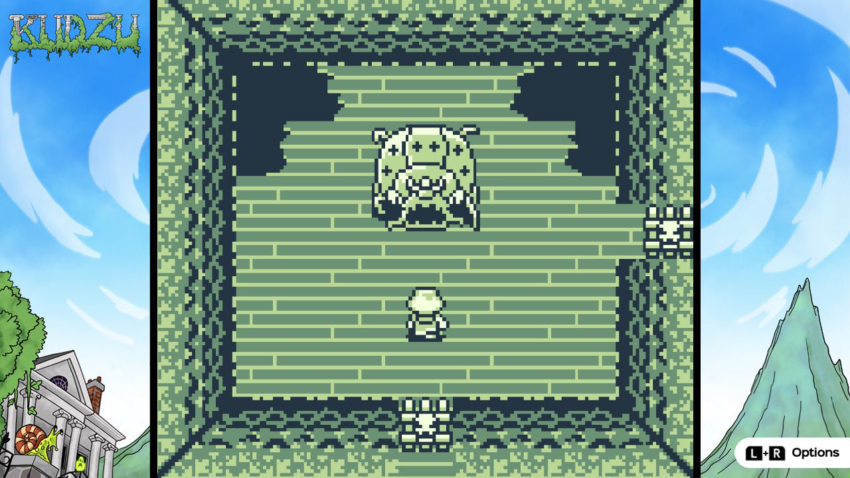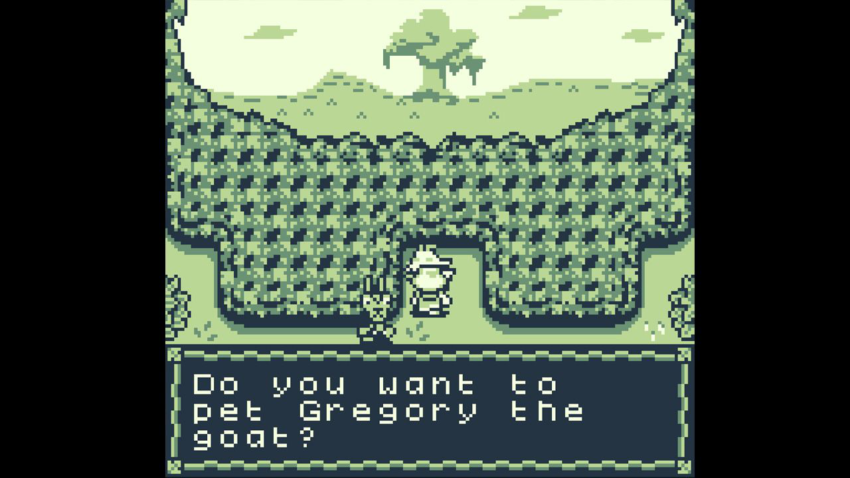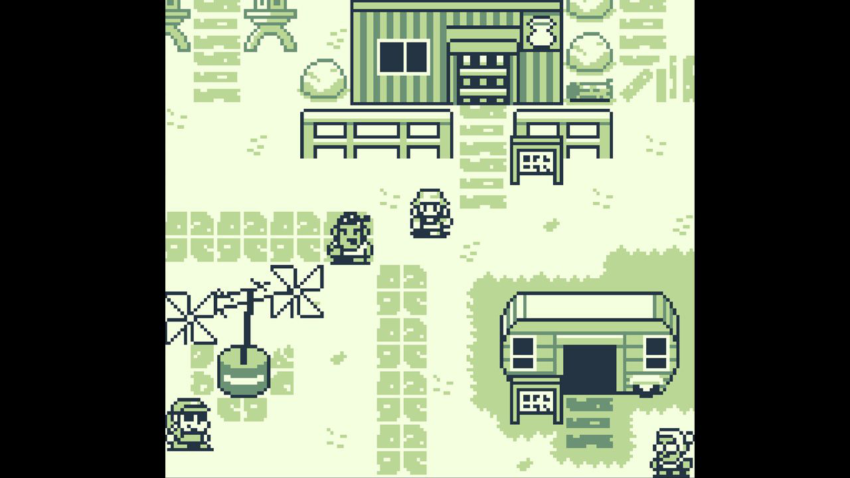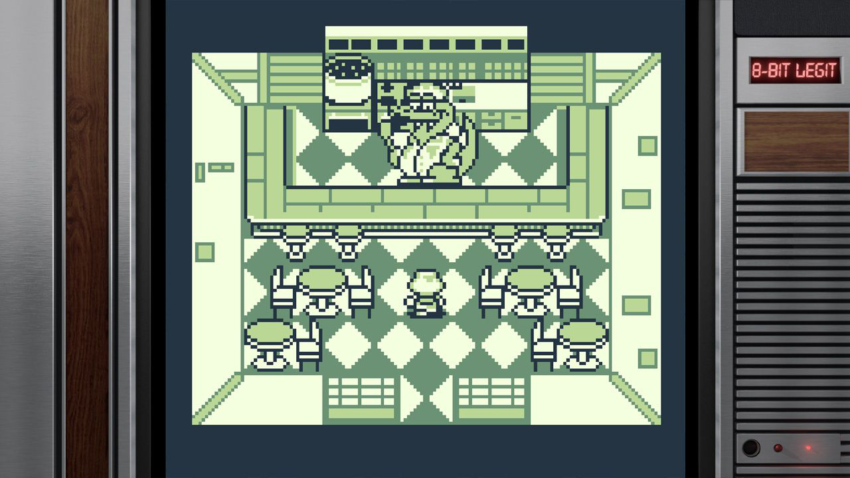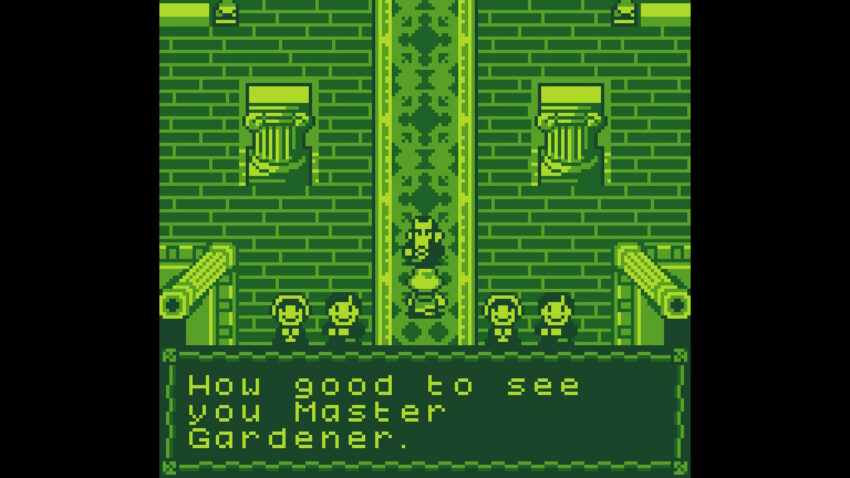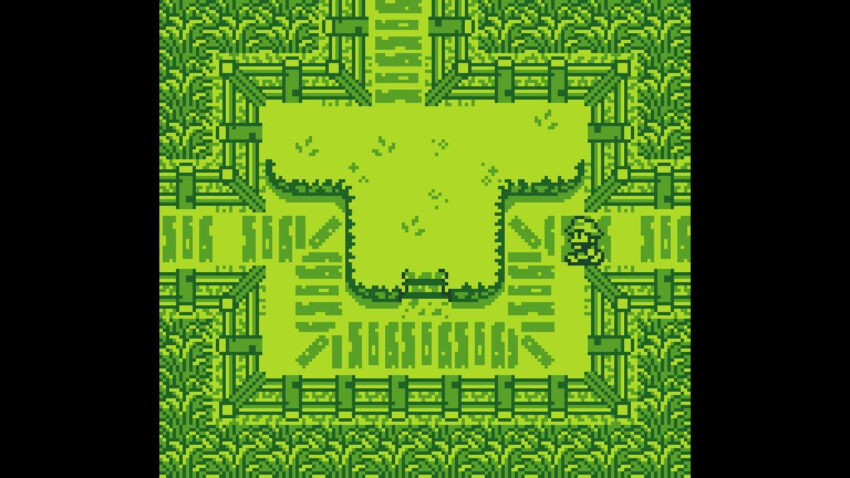Review: Retro-Inspired Indie “Kudzu” Is a Familiar Yet Fresh Throwback to Zelda’s Game Boy Adventures
Posted on April 20 2024 by Nick Miller
The year is 2024. Video games are pushing graphical and technological boundaries, constantly broadening our perspective on what the medium is capable of. New hardware and AI technology open the door for new possibilities as we creep ever closer to games that are indistinguishable from real life. Amidst this sea of innovation, a new Game Boy game was released. No, I didn’t say a Game Boy-inspired game, but a real, bona fide Game Boy game.
Developed by Pie For Breakfast Studios, Kudzu is the newest game from publisher 8-Bit Legit, which specializes in bringing “new authentic retro” games to modern and classic consoles alike. This means that, in addition to Kudzu being available on the Nintendo Switch eShop like most modern indie titles, players can dust off their Game Boy and play the game on classic hardware.
Game Designer Chris Totten took inspiration for Kudzu from the real-life invasive kudzu vines in the American South, which are slowly but surely strangling our Dixie. He said:
“The game came from a bunch of ideas that my wife and I pulled together, including her brother fighting off invasive vines in their yard with a machete and my dealing with a kudzu-infested building site in architecture school.
“Kudzu is a game I’ve wanted to make for a long time both because of my love of action-adventure games like Zelda and Metroid, but also because I thought an evil, world-consuming invasive plant would make for some really cool gameplay. Kudzu wraps its tendrils around the level layouts, the puzzle elements, the enemies, everything: and that was a really cool design theme to play with.”
Of course, being in a video game, the kudzu of Kudzu is more than just an invasive weed. You’ll unlock its mysteries and more as you explore this throwback to classic handheld adventures like Link’s Awakening, the Oracle games, and Final Fantasy Adventure. But let’s start this tale from the beginning.
A Missing Master Gardener
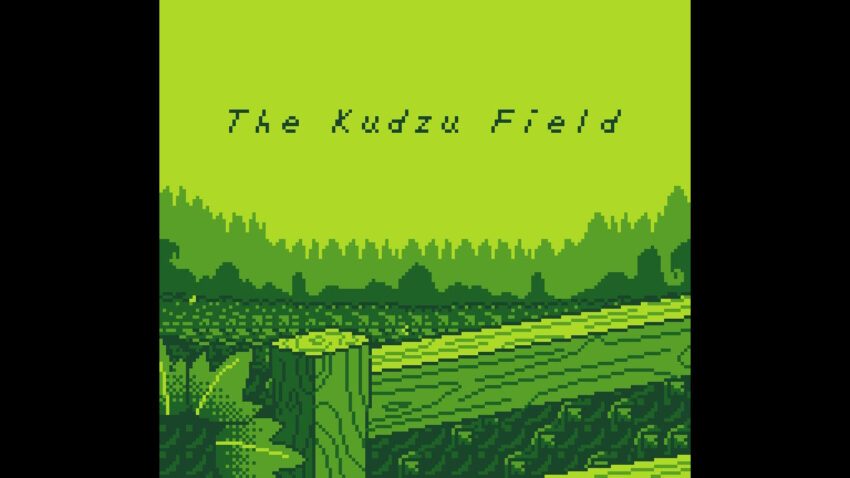
Kudzu kicks off with players taking control of Max, the hard-working apprentice of Zoen, the self-proclaimed “Master of Master Gardeners.” Max learns that Zoen has gone missing, leaving behind just a note which says he has gone into the labyrinthian kudzu fields to contend with the source of the plant. So, Max sets off to find his missing master, unwrapping a sinister plot as he discovers the source of the invasive plant and the mystery surrounding the estate from which the vines emanate.
The premise is simple enough, but it’s an effective motivator for players on their journey. Each step along the way manages to peel back the mystery little by little while continuing to raise more questions. The story and its themes escalate naturally, never feeling forced or out of place. By the game’s conclusion, the plot is tackling an ethical dilemma of perfection at the cost of freedom versus freedom at the cost of perfection — a relevant yet timeless theme.
Thankfully, this didn’t come at the cost of the experience. As someone with an aversion to lengthy cutscenes and walls of text, I appreciated that dialogue was concise, never veering into preachy self-righteous messaging that pervades many well-meaning indie games. Kudzu effectively communicates what it needs to and never tries to be anything that it’s not. It’s a video game that prioritizes a fun experience first and foremost, and it’s all the better for it.
A Fresh Take on Familiar Gameplay
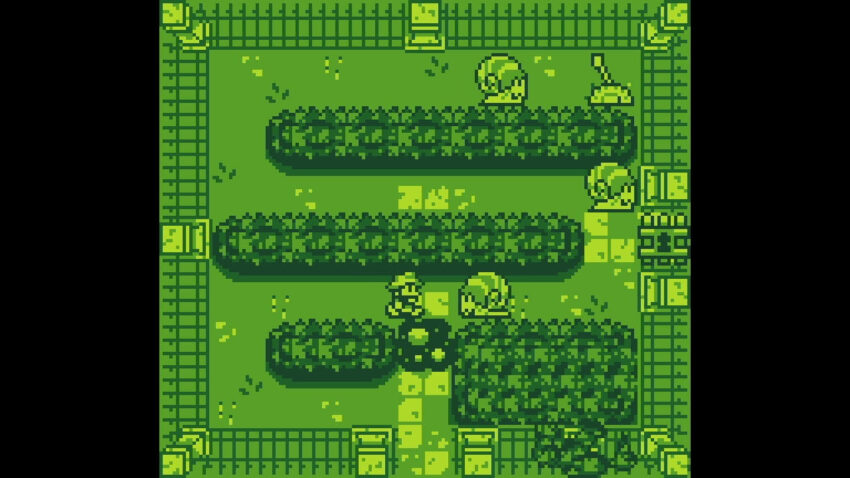
Anyone familiar with Link’s Awakening or other like games will feel right at home in Kudzu. It’s a two-button adventure game with free exploration and a Metroidvania-esque style of item-driven progression. The hub world is made up of a small town with a shop and a few houses. Surrounding it are themed areas: a farm, a decorative garden, a haunted mansion, and a dreary forest. These areas act as the game’s “dungeons.” The kudzu vines form each region into mazes that are littered with enemies and puzzles.
Max’s main weapon will be his machete, which he uses to fight monsters and kudzu vines alike. The monsters that populate the world of Kudzu are the standard assortment you’d expect from a game like this: spiders, ghosts, crabs, etc.. Aside from the bosses and one enemy type that is a kudzu-possessed suit of armor, nothing should surprise you. There’s some variety in how you fight enemies, but again, it’s pretty much what you’d expect. For crabs, you have to wait until their attack animation is finished before you can retaliate. Meanwhile, Snails’ shells protect their back, so you must attack from the front. The monsters are perfectly serviceable and make for enjoyable gameplay, but don’t expect anything too out of the ordinary.
Along with the machete, Max has a variety of garden tools in his arsenal, like a rake, a hoe, and a pair of heavy-duty boots. Something unique about how the game handles Max’s equipment is that it can all be used with either your attack button or the action button without having to swap items in the menu. Do you need to use your rake? Well, it functions the same as your machete, so swing away. This feature streamlines gameplay and keeps up the pace. Given that one of my main complaints about games like Link’s Awakening or the Oracle games is that some dungeons will have you constantly jumping in and out of menus to switch items, much like the Iron Boots in Ocarina of Time‘s Water Temple, this was a welcomed inclusion… on paper.
Despite keeping the gameplay moving, this system of using equipment doesn’t come without some drawbacks. Since each item is automatically mapped to an existing action, each item is incredibly limited in its utility. Each acts as less of a unique piece of equipment and more of a modification to existing actions. In that sense, items are really nothing more than keys to open doors. If the player were to, say, collect colored keys that unlocked doors of corresponding color and were able to permanently keep those keys in their inventory, they would function identically to the gear you collect in Kudzu. Having these keys be a rake or a hoe, and having the doors be piles of leaves or a patches of rough dirt, is clearly a more interesting presentation, but the level of depth is about the same.
Another unique gameplay mechanic is found in how Kudzu handles boss keys (or the lack thereof). Dungeon boss rooms are blocked by a wall of kudzu vines, and in order to pass through, you must dispel the vines by destroying its roots. These roots are scattered throughout the dungeon and can be destroyed with your sword. This means that the player must search every nook and cranny to find the exposed roots. Despite never being too difficult, the task adds a welcomed layer of depth to exploration that you won’t always find with the tried and true “find the boss key and beeline to the end of the dungeon” approach to level design.
There is a funny glitch with the roots, however. If you continue to swing your machete through their destruction animation, it will be counted as two destroyed roots instead of one. It’s so obvious and easy too pull off that most players will probably encounter it by accident. Players could therefore exploit this glitch to rob themselves of the authentic experience by skipping large chunks of the dungeon. However, I found in my playthrough that I didn’t even want to skip any of the roots, even when the boss’ door was already opened, because exploring the dungeon was so much fun that I didn’t want to miss out on anything.
Getting Lost in the Weeds
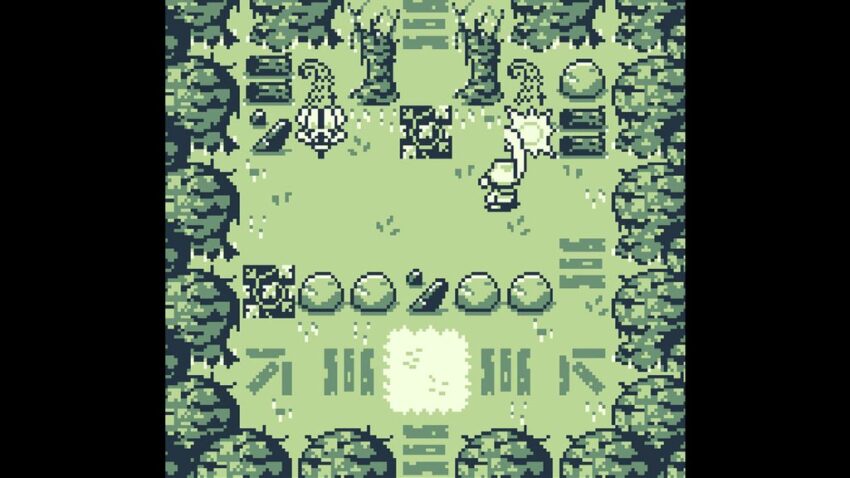
When it comes to retro-inspired modern games, I expect to see updates and improvements that reflect our modern understanding of game design while keeping the essence of those classic games intact. However, since Kudzu is literally made for retro hardware, I had to keep reminding myself that the Game Boy’s hardware limitations are at play and that fact may make this game feel older than it really is.
As such, Kudzu has certain qualities that could have certainly been improved upon had it forgone the cartridge release and been designed with solely modern consoles in mind, as other retro-inspired titles have done. For example, as someone with no nostalgia for the green-tinted Game Boy screen, I would have really liked to have the option to switch between the classic green-tint and full color (perhaps a Kudzu DX mode). That would, however, prevent it from running on original hardware. Likewise, the frame rate slows significantly when multiple assets are on screen at once — certainly a product of hardware limitations. Thankfully, the hardware is just a minor hindrance to the overall experience and is only the cause of a few very minor issues.
That being said, I have some criticisms that transcend hardware limitations. These complaints are each small on their own, but they add up to what seems like a general lack of polish. For starters, there aren’t many sound effects. You know how in Link’s Awakening and pretty much any other adventure game, swinging your sword makes a fwip sound? This sound effect creates a small mental reward for your action and further aids in combat by making different noises when your attack connects with the enemy or when it connects ineffectively, like a clink when you hit an enemy shield. Kudzu lacks audio cues in combat outright. This was really discouraging at times because I wasn’t sure if my attacks were doing anything or not, especially in boss fights. I know it’s a minor thing, but it felt unnatural. Imagine Mario without the boing in his jump, or Pac-Man without his signature womp womp womp; they just wouldn’t feel right.
Another problem with combat involves the relationship between knockback and invincibility frames. Knockback is when your character is pushed back a few paces as the result of an action; in Kudzu, this happens when you take damage from an enemy. Invincibility frames refers to the short window after your character takes damage in which they are invincible (like how Mario’s sprite blinks and can run through enemies for a short time after being hit). The knockback in Kudzu is erratic. From what I can tell, it moves your character in the reverse of the direction in which you are holding the D-pad, but that theory may need more testing. Regardless, when you take damage, Max is knocked back a somewhat significant distance and moves in multiple directions. This often sends you into other enemies or up against a wall where you will be cornered and knocked back further. This experience wouldn’t be too bad by itself, but the invincibility frames are so quick that they are almost nonexistent. By the time the player regains control of Max, the enemy will often have had time to catch up to you and strike you again before you have a chance to perform another action.
Next, as you may notice from the screenshots, Max’s health and Mushrooms (in-game currency) are not listed on the screen. This means you need to open the menu to check them. For all of the advances Kudzu made by eliminating the need to open a menu to manage inventory, it took two steps back by making the player consult a menu to check their health and currency. Doing this with Mushrooms would be fine if they at least displayed on the screen when inside a shop, but they don’t. So, unless you like doing mental math, you’ll have to open your menu between each purchase to see how many Mushrooms you have. And unlike your health, Mushrooms aren’t displayed conveniently on the menu page. The player must scroll over to the Mushroom icon and select it in order to see how much currency you currently have. While this isn’t impossible to manage, it is unnecessarily inconvenient.
As for health, you either have to count the hits you take or regularly check the menu in the middle of combat to know where you currently stand. To its credit, there is a small heart that displays above Max when his health is at half and a quarter, but when coupled with the knockback and invincibility frame issues, this does little to give the player an accurate assessment of their health and is more so just an indicator for the player to open the menu. I can appreciate wanting to de-clutter the screen by removing a heads-up display, but at least offering a health readout as an option for players to toggle on or off would have been a suitable compromise.
My last criticism is of the menu itself. For reasons unbeknownst to me, buttons are incredibly unresponsive in the menu. Anywhere else in the game, movement and button presses are quick and responsive, so why should the menu any different? More often than not, I found myself mashing the D-pad to move the cursor because a single button press was never enough.
Another interesting quirk with the menu is that it resets puzzles and enemy placement every time you open it. Pie For Breakfast Studios acknowledged this as a product of software limitations, so I wouldn’t necessarily call it a bad thing, but it can unfortunately be used to cheese some bosses by camping and exploiting their reset point by repeatedly opening and closing the menu. Of course players with self-control won’t have any issue with this, but it has opened the door for others to rob themselves of a genuine experience.
A Fitting Homage
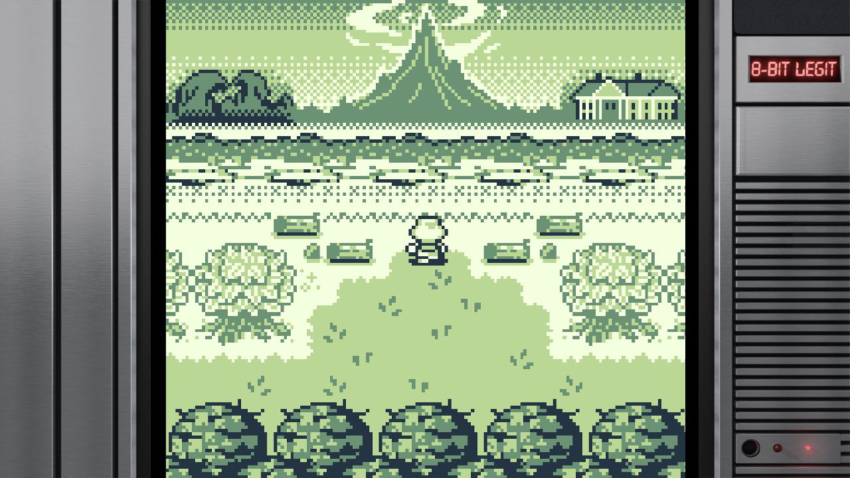
The criticisms that I have of Kudzu aren’t meant to discourage you from playing it, but rather to give you an appropriate expectation before jumping in. It really is a fun game! I had a great time from start to finish, and, interestingly enough, it was one of those rare games that I actually enjoyed more the longer I played it. By the time it wrapped up, I was left hoping for more because I felt like there were so many more places to go with the foundation that had already been set.
Of course, most of the standard compliments can be attributed to Kudzu. The gameplay is familiar yet fresh. The music suits the game well. The pacing is on point, and it doesn’t waste the player’s time with pointless filler. There is also little to no hand-holding, which is particularly noticeable at the start of the game, as the player is almost immediately dropped into the action with no quest marker telling you where to go. Sure, there is a correct next step, but it’s up to the player to find it, and the game naturally leads you there without making you feel like you’re on a guided tour. Never once did the game throw up an arbitrary roadblock, so it always felt like I, the player, was in control, even when there were subtle nudges in the right direction.
Despite being an homage to Game Boy Zelda games, some of the best things about Kudza are the things it does to set itself apart. First is its setting. It takes place in what I can only assume is a modern interpretation of the American South. That may not seem like a big deal, but it’s a unique setting for a Zelda-like adventure game. It almost reminds me of Star Tropics or Earthbound in the sense that it took a genre that is typically reserved for fantasy settings and brought it into the modern age.
Aforementioned gameplay mechanics like streamlined equipment and having to snuff out kudzu roots to open boss’ doors are just a few other ways in which Kudzu stands out from the games that inspired it. Another unique element is using kudzu plants to solve puzzles. Every dungeon has puzzles where the player will have to defeat creatures that are eating the kudzu, let the kudzu grow (rather rapidly), and then clear a path for the vines to extend to rusty or unreachable levers. Unfortunately, these puzzles are never difficult. You will often know exactly what needs to be done the second you step into the room. Even then, they provide a unique gameplay experience and a solid foundation for a style of puzzle that has the potential for greater depth. And that’s a theme you’ll notice with a lot of things in Kudzu: interesting mechanics that would benefit from being fleshed out a bit more.
Conclusion
Kudzu is, more than anything, a game worth playing. It is literally a Game Boy adventure made for Game Boy hardware, but it isn’t content retreading old ground. From a unique setting and premise that gives almost supernatural qualities to a real-world issue, to the familiar yet fresh top-down adventure gameplay, Kudzu always found new ways to entertain, intrigue, and surprise me. Even though Kudzu has a considerable lack of polish in many aspects, do yourself a favor and don’t get lost in the weeds with this one. Shed off that modern lens and think of Kudzu as the Game Boy game it is, because I have no doubt that, if it had come out 30 years ago, it would be considered a classic.
Zelda Dungeon’s Score: 6.5/10
Kudzu is available for $4.99 USD on the Nintendo Switch eShop. For all of you collectors out there, you can pick up a physical copy for the Game Boy for $49.99 USD through Mega Cat Studios.
Do you plan to pick up Kudzu? Let us know in the comments below.
This review was conducted on the Nintendo Switch. Review copy provided by 8-Bit Legit.

Nick is a writer for Zelda Dungeon and a longtime fan of the Zelda franchise. In his free time, he enjoys fishing, archery, skateboarding, and some good ol’ fashioned family time. He’s an advocate for physical media and an avid video game collector. His favorite Zelda game is Ocarina of Time, though Breath of the Wild and the Link’s Awakening remake are close contenders.



